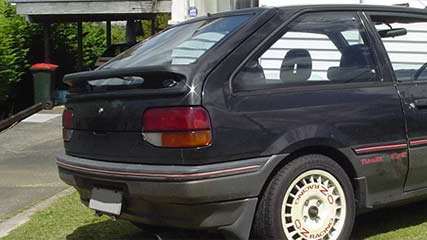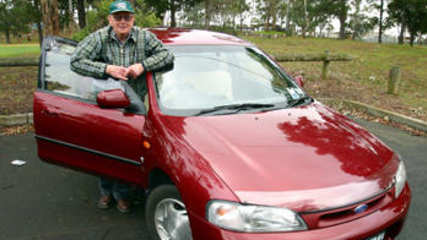Used Ford Laser review: 1994-1996
By Graham Smith · 23 Jan 2009
The Laser was a shining light for Ford during the 20-plus years it was part of the blue oval’s family. The Mazda-based small car was popular, from the first model in 1981 right through to the last, which was replaced by the Focus in 2002.Such was the popularity of the Laser badge that it’s hard to understand why Ford dropped it in favour of the Focus, which was a completely unknown badge here.The Lasers that preceded the KJ were pretty much just rebadged Mazda 323s, but the KJ was an attempt to move a little further away from the Mazda. For the first time there was even a unique body style, one that wasn’t included in the Mazda catalogue.It was also unique in that it was imported from Japan whereas the preceding models had been built locally at Ford’s Homebush plant in Sydney.MODEL WATCHFord raised the wraps on the KJ Laser late in 1994 with an expanded range of three models encompassing three quite different body styles.There was a four-door sedan, which made use of the Mazda 323 body with unique Ford-styled sheetmetal front and rear. A new name, Liata, appeared on the five-door hatch, while the racy three-door Lynx hatch was aimed squarely at the youth market.Ford’s stylists took the Mazda 323 sedan and reworked it with a smoother front incorporating a larger bumper and unique headlamps, and sharper boot and tail lamps to distinguish the rear.Like most new models, the KJ Laser was bigger than the model it replaced. Its wheelbase was 105 mm longer than the KH’s, and the track was 30 mm wider, adding up to significantly more head and shoulder room in the front, and 25 mm more legroom in the rear.It was the Liata five-door hatch that really started the move away from the Laser’s 323 roots. Ford regarded the Liata as the main model in the Laser range, having recognised the popularity of hatches in the local market.When small sedans were typically bought by older buyers locked into tradition, the hatch appealed to younger buyers, mostly families, who appreciated the flexibility a hatch gave them.The Liata was a smoothly styled hatch that showed that hatches didn’t have to be unpleasant boxes to deliver the function hatch buyers valued so much. Apart from a sportier grille the Liata was the same as the sedan forward of the windscreen, but from there back it was all new.With a steeply raked roofline, spoiler mounted on the rear window, and large roundish tail lamps it cut a dashing profile. It was also slightly shorter than the sedan, due to its shorter rear overhang, but that didn’t impact on its interior roominess.There was no mistaking a Lynx, nor was it possible to mistake its purpose. The three-door Laser cut a rakish figure on the road, with its large headlamps that cut into the bonnet and bumper, its sharply bobbed tail with a spoiler mounted on the rear glass, and its egg-shaped rear lamps all making a bold statement that no Laser had previously done.The Lynx sat on a 100 mm shorter wheelbase, with a rear overhang shorter than both the Liata and LXi.Power was delivered by one of two engines, a 1.6-litre ‘economy’ engine, or a larger 1.8-litre ‘performance’ unit.Both were double overhead camshaft engines, with sequential fuel-injection and variable intake, which was designed to deliver torque at the low end when the intake tract was longer, and power at the top end when the tract was shorter.The 1.6-litre so-called ‘economy’ engine was standard in the LXi and Liata. It produced 80 kW at 6000 revs and 143 Nm at 3500 revs, representing an increase of 25 per cent in power and 16 per cent in torque over the carb-fed KH engine.The larger 1.8-litre engine was optional on the LXi and Liata, and standard on the Lynx. A similar unit to the smaller 1.6-litre engine it put out 92 kW at 6000 revs and 160 Nm at 4000 rpm, a slight increase over the KH’s 1.8-litre.Drive was delivered to the front wheels through an upgraded five-speed manual, which featured synchromesh on reverse for smoother selection of reverse gear, or a four-speed electronic auto.Underneath the shapely skin lay MacPherson Strut suspension, front and rear, with slightly higher spring and shock rates for a sportier feel when the 1.8-litre engine was selected.All models had power steering, retuned for reduced effort and improved on-centre feel. Brakes were discs all round, with a larger master cylinder for a more solid pedal feel, and ABS was optional on the LXi and Liata and standard on the Lynx.Inside there was a new dash, moulded door trims, more supportive seats with height and tilt adjustment, and upgraded sound systems.Dual airbags were initially only available as an option on the models with the 1.8-litre engine, standard on the Lynx, but also became available with the 1.6-litre engine from early 1995.The entry-level model on the Sedan and Liata was the LXi, and there was a Ghia luxury upgrade available as well. When selected the Ghia brought the 1.8-litre engine, alloy wheels, central locking, power mirrors, power windows, and four-speaker sound.IN THE SHOPThe KJ was imported from Japan instead of being built here, and that means better build quality.Add to that a stiffer body than those of the preceding models and you have a car that stands up well to the rigours of a life in the daily grind of our cities. The KJ is not a car that suffers from rattles and squeaks, unless it has been involved in a crash and poorly repaired.Check carefully for the tell tale signs of crash repairs, like colour mismatches between adjacent panels, poorly fitting doors and hatches, and irregular panel gaps.Mechanically the KJ is sound, the engines are reliable and give little trouble, but look for a service record to ensure your potential buy has regularly seen the inside of a reputable service shop.OWNERS’ VIEWSWally Turner bought his 1.8-litre auto Liata hatch new in 1994. It has now done 115,000 km, and he’s more than happy with it, having only had to replace the tyres and the water pump. Wally says he gets 8 L/100 km on the highway and 10 round town.David McClean says his 1994 1.6-litre Liata LXi five-door hatch has 100,000 km on the odometer and is running like a dream. David says the 1.6-litre has sufficient grunt, the space in the back when the seats are down is great. The only negative is the visibility out the back window.LOOK FOR• stylish small car, apart from wild Lynx• good reliable Mazda mechanical package• roomy interior will handle four adults with their luggage• well balanced and responsive handlingTHE BOTTOM LINE• attractive styling with Mazda build quality, safety and reliability make the KJ was good buy as a second car or first car for beginner drivers.RATING65/100


_GL_5-door_hatchback_1990-1991_01LR.jpg)





